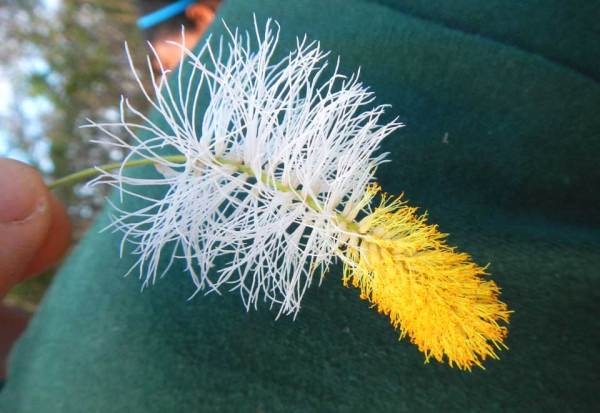by Dennis Giardina
To recap, in 2007, Park Biologist Mike Owen and I entered into collaboration with Matt Richards from Atlanta Botanical Garden to experimentally restore rare and endangered orchid species at Fakahatchee Strand Preserve State Park. I have written several articles (1) over the years about our effort to restore the cigar orchid, Cyrtopodium punctatum.
I have also written about our effort to find a seed source for two of Fakahatchee’s “lost orchids,” the rat-tail orchid, Bulbophyllum pachyrachis, and Acuña’s Epidendrum, Epidendrum acunae. The closest, wild populations of those two species occur in Western Cuba. I have written (2) about the trip to Cuba that Mike and I took last year in October to attend an international orchid conservation conference where we co-presented a paper in Spanish and English on our Fakahatchee cigar orchid restoration project and where we made a very fortuitous find.
Unbelievably the two very obscure orchid species we were looking for, our “lost orchids,” we found growing at Soroa Botanical Garden, the site of our conference. There were multiple individuals of both species that were grown from seed collected from wild plants in the Rosary Mountains Biosphere Preserve. We just happened to be there during the height of rat-tail blooming season and we were ecstatic to find a half dozen of their rat-tail orchids in flower; one of them had a ripening seed capsule on it!
I was expecting a much stricter environment, but one interesting thing we found while travelling to Cuba was the relative ease of entry into the country. I fully expected to be questioned, perhaps interrogated when we touched ground at Jose Marti International Airport but that was not the case. I also expected to see a lot more military and police presence, especially in Havana, but again, not so. There was a lot of e-mail correspondence between me and Dr. Rolando Perez, Director of Science at Soroa Botanical Garden, without any apparent official interference. When I returned from the conference, I continued to e-mail with him, including sending him photos and he received them all.
When I left Soroa, I told him that I wanted him to collect a rat-tail orchid seed capsule for me and that I would be back eventually to collect it. He said that the rat-tail orchids in the shade house were often pollinated by an unknown insect and seed capsules formed on them most years. Even though there didn’t seem to be any government scrutiny of our e-mails, I still tried to be very careful about what I wrote in my e-mails. So, between October 2012 and May 2013, when I went back to Cuba for a Nature Conservancy-sponsored training, I did everything but come right out and say “Make sure you save a rat-tail orchid seed capsule for me!”
I brought with me various gifts and supplies for the Botanical Garden, including an autoclave, which is like a big pressure cooker that is used to sterilize the instruments necessary to grow orchids from seed. Their laboratory needed one and Mike Owen found that Wally Wilder, who has assisted him on Central Slough surveys had one and was willing to donate it. My wife begged me not to take the autoclave because she was sure it would get me in trouble. This, my 2nd trip to Cuba in six months, took place not long after the Boston Marathon bombing and the despicable individuals who did it used very similar-looking pressure cookers for their explosives. Dr. Dalia Salabarría, our host and the Director of the National Center for Protected Areas, met us at the airport and she got us and the autoclave right through customs with only quizzical looks from the inspectors.
Our week-long training focused on prescribed fire and invasive plant management and was seemingly very well received by the scientists and land managers who attended. We went all over Western Cuba and when it ended, I visited Soroa Botanical Garden. After I arrived, I waited patiently, biding my time to bring up the question of my rat-tail orchid seed capsule.
At some point while sitting with Dr. Perez and his daughter Yunelis in his office, I finally asked, “So… were you able to collect a rat-tail seed capsule for me?”
Dr. Perez looked at me with a deer-in-the-headlights look and said, “Seed capsule, I didn’t know you wanted me to collect a seed capsule?”
Folks, I have ridden some waves of disappointment in my life, but when he told me that, I felt faint. My vision was reduced to a single point of light, like the screen of an old television set when you shut it off.
I somehow managed to regain my composure and asked if by any chance there were any seed capsules left on any of the rat-tail orchids? When we went out to the greenhouse – there was only one, tiny, withered seed capsule on one of the plants. He snipped it off and I folded it up into a piece of paper and I didn’t even look at it until I handed it to Matt Richards, who took it back to Atlanta Botanical Garden. When he looked at it under a microscope, he found that there were no viable seeds. To be continued…
Dennis Giardina is the Everglades Region Biologist for the Florida Fish and Wildlife Conservation Commission and was formerly the Park Manager of Fakahatchee Strand Preserve.
(1) The Ghost Writer, January 2010 and May 2010
(2) The Ghost Writer, January 2013 and April 2013




